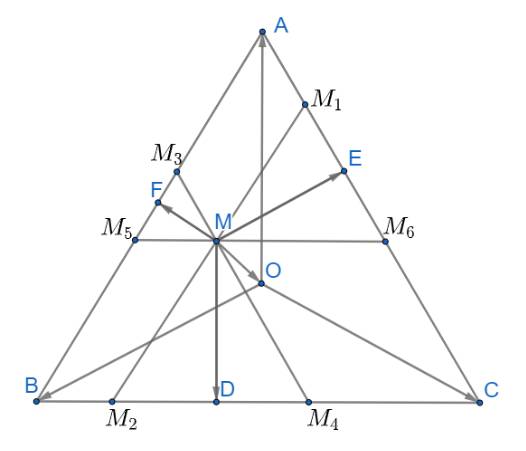Cho tam gics abc, gọi G là trọng tâm. Chứng minh rằng \(\overrightarrow{AG}=\frac{1}{3}\overrightarrow{AB}+\frac{1}{3}\overrightarrow{AC}\)
Hãy nhập câu hỏi của bạn vào đây, nếu là tài khoản VIP, bạn sẽ được ưu tiên trả lời.


Với điểm M bất kì ta có: \(\overrightarrow {MA} + \overrightarrow {MB} + \overrightarrow {MC} = 3\overrightarrow {MG} \)
Chọn M trùng A, ta được: \(\overrightarrow {AA} + \overrightarrow {AB} + \overrightarrow {AC} = 3\overrightarrow {AG} \Leftrightarrow \overrightarrow {AB} + \overrightarrow {AC} = 3\overrightarrow {AG} .\)

\(\overrightarrow {MD} + \overrightarrow {ME} + \overrightarrow {MF} = \left( {\overrightarrow {MO} + \overrightarrow {OD} } \right) + \left( {\overrightarrow {MO} + \overrightarrow {OE} } \right) + \left( {\overrightarrow {MO} + \overrightarrow {OF} } \right)\)
Qua M kẻ các đường thẳng \({M_1}{M_2}//AB;{M_3}{M_4}//AC;{M_5}{M_6}//BC\)
Từ đó ta có: \(\widehat {M{M_1}{M_6}} = \widehat {M{M_6}{M_1}} = \widehat {M{M_4}{M_2}} = \widehat {M{M_2}{M_4}} = \widehat {M{M_3}{M_5}} = \widehat {M{M_5}{M_3}} = 60^\circ \)
Suy ra các tam giác \(\Delta M{M_3}{M_5},\Delta M{M_1}{M_6},\Delta M{M_2}{M_4}\) đều
Áp dụng tính chất trung tuyến \(\overrightarrow {AM} = \frac{1}{2}\left( {\overrightarrow {AB} + \overrightarrow {AC} } \right)\)(với M là trung điểm của BC) ta có:
\(\overrightarrow {ME} = \frac{1}{2}\left( {\overrightarrow {M{M_1}} + \overrightarrow {M{M_6}} } \right);\overrightarrow {MD} = \frac{1}{2}\left( {\overrightarrow {M{M_2}} + \overrightarrow {M{M_4}} } \right);\overrightarrow {MF} = \frac{1}{2}\left( {\overrightarrow {M{M_3}} + \overrightarrow {M{M_5}} } \right)\)
\( \Rightarrow \overrightarrow {MD} + \overrightarrow {ME} + \overrightarrow {MF} = \frac{1}{2}\left( {\overrightarrow {M{M_2}} + \overrightarrow {M{M_4}} } \right) + \frac{1}{2}\left( {\overrightarrow {M{M_1}} + \overrightarrow {M{M_6}} } \right) + \frac{1}{2}\left( {\overrightarrow {M{M_3}} + \overrightarrow {M{M_5}} } \right)\)
Ta có: các tứ giác \(A{M_3}M{M_1};C{M_4}M{M_6};B{M_2}M{M_5}\) là hình bình hành
Áp dụng quy tắc hình bình hành ta có
\(\overrightarrow {MD} + \overrightarrow {ME} + \overrightarrow {MF} = \frac{1}{2}\left( {\overrightarrow {M{M_2}} + \overrightarrow {M{M_4}} } \right) + \frac{1}{2}\left( {\overrightarrow {M{M_1}} + \overrightarrow {M{M_6}} } \right) + \frac{1}{2}\left( {\overrightarrow {M{M_3}} + \overrightarrow {M{M_5}} } \right)\)
\( = \frac{1}{2}\left( {\overrightarrow {M{M_1}} + \overrightarrow {M{M_3}} } \right) + \frac{1}{2}\left( {\overrightarrow {M{M_2}} + \overrightarrow {M{M_5}} } \right) + \frac{1}{2}\left( {\overrightarrow {M{M_4}} + \overrightarrow {M{M_6}} } \right)\)
\( = \frac{1}{2}\overrightarrow {MA} + \frac{1}{2}\overrightarrow {MB} + \frac{1}{2}\overrightarrow {MC} = \frac{1}{2}\left( {\overrightarrow {MA} + \overrightarrow {MB} + \overrightarrow {MC} } \right)\)
\( = \frac{1}{2}\left( {\left( {\overrightarrow {MO} + \overrightarrow {OA} } \right) + \left( {\overrightarrow {MO} + \overrightarrow {OB} } \right) + \left( {\overrightarrow {MO} + \overrightarrow {OC} } \right)} \right)\)
\( = \frac{1}{2}\left( {3\overrightarrow {MO} + \left( {\overrightarrow {MA} + \overrightarrow {MB} + \overrightarrow {MC} } \right)} \right) = \frac{3}{2}\overrightarrow {MO} \) (đpcm)
Vậy \(\overrightarrow {MD} + \overrightarrow {ME} + \overrightarrow {MF} = \frac{3}{2}\overrightarrow {MO} \)


a/ \(\overrightarrow{AC}=3\overrightarrow{AM};\overrightarrow{BN}=\frac{1}{2}\overrightarrow{BC}\)
\(\overrightarrow{MN}=\overrightarrow{MA}+\overrightarrow{AB}+\overrightarrow{BN}=\frac{1}{3}\overrightarrow{CA}+\overrightarrow{AB}+\frac{1}{2}\overrightarrow{BC}\)
\(=\frac{1}{3}\overrightarrow{CB}+\frac{1}{3}\overrightarrow{CD}+\overrightarrow{DC}+\frac{1}{2}\overrightarrow{BC}=\frac{2}{3}\overrightarrow{DC}+\frac{1}{6}\overrightarrow{BC}=\frac{2}{3}\overrightarrow{AB}+\frac{1}{6}\overrightarrow{BA}+\frac{1}{6}\overrightarrow{AC}=\frac{1}{2}\overrightarrow{AB}+\frac{1}{6}\overrightarrow{AC}\)
Hmm, MN làm sao vuông góc vs BC đc. Nó chỉ vuông góc khi M là TĐ của AC thôi, bởi N là trung điểm của BC rồi mà, hại não :((
2/\(\overrightarrow{BK}=\frac{4}{13}\overrightarrow{BA}\Rightarrow\overrightarrow{BC}+\overrightarrow{CK}=\frac{4}{13}\overrightarrow{BC}+\frac{4}{13}\overrightarrow{CA}\)
\(\Leftrightarrow\overrightarrow{CK}=\frac{9}{13}\overrightarrow{CB}+\frac{4}{13}\overrightarrow{CA}\)
\(\overrightarrow{GB}+\overrightarrow{GM}+\overrightarrow{GN}=\overrightarrow{0}\)
\(\Leftrightarrow\overrightarrow{GC}+\overrightarrow{CB}+\overrightarrow{GC}+\overrightarrow{CM}+\overrightarrow{GC}+\overrightarrow{CN}=\overrightarrow{0}\)
\(\Leftrightarrow3\overrightarrow{GC}+\overrightarrow{CB}+\overrightarrow{CN}+\overrightarrow{NM}+\overrightarrow{CN}=\overrightarrow{0}\)
\(\Leftrightarrow3\overrightarrow{GC}+\overrightarrow{CB}+2\overrightarrow{CN}+\frac{1}{2}\overrightarrow{BA}+\frac{1}{6}\overrightarrow{CA}=\overrightarrow{0}\)
Ta có : \(\overrightarrow{CN}=\frac{1}{2}\overrightarrow{CB}\Rightarrow3\overrightarrow{GC}+\overrightarrow{CB}+\overrightarrow{CB}+\frac{1}{2}\overrightarrow{BA}+\frac{1}{6}\overrightarrow{CA}=\overrightarrow{0}\)
\(\Leftrightarrow\overrightarrow{CG}=\frac{2}{3}\overrightarrow{CB}+\frac{1}{6}\overrightarrow{BA}+\frac{1}{18}\overrightarrow{CA}\)
\(\Leftrightarrow\overrightarrow{CG}=\frac{2}{3}\overrightarrow{CB}+\frac{1}{6}\overrightarrow{BC}+\frac{1}{6}\overrightarrow{CA}+\frac{1}{18}\overrightarrow{CA}\)
\(=\frac{1}{2}\overrightarrow{CB}+\frac{2}{9}\overrightarrow{CA}\)
Có \(\overrightarrow{CK}=\frac{18}{13}\overrightarrow{CG}\Rightarrow\) C,G,K thẳng hàng
toán lớp mấy đó bạn
Mình giải được rồi nheeee